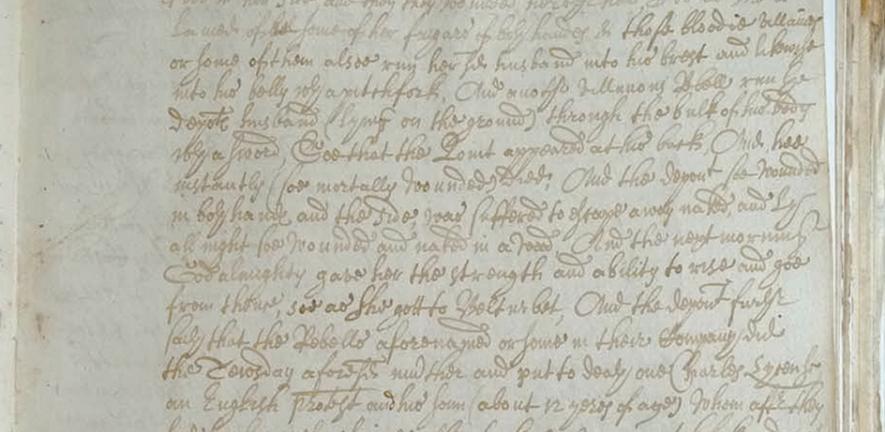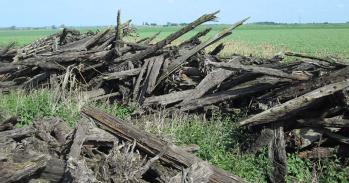
John Morrill explores one of the most extraordinary and least understood aspects of Anglo-Irish history - the rebellion of 1641.
John Morrill explores one of the most extraordinary and least understood aspects of Anglo-Irish history - the rebellion of 1641.
But was the rebellion intended to be a bloodless coup that spiralled out of control, or were the thousands of Protestants deliberately driven out and massacred?
The true course of events of the Irish rebellion of 1641 has never been fully known. Initiated by disaffected Irish Catholics rebelling against Protestant settlers, the rebellion quickly escalated in violence, resulting in widespread killing. But was the rebellion intended to be a bloodless coup that spiralled out of control, or were the thousands of Protestants deliberately driven out and massacred? What’s clear is that the years that followed were a time of savage revenge for the events of 1641 – Oliver Cromwell arrived with 30,000 English troops to conquer Ireland in the name of the English Republic and to exact ‘a just judgement of God upon those barbarous wretches, who have imbrued their hands in so much innocent blood’ – and the groundwork was laid for Ireland’s Catholic–Protestant divide.
A curious aspect of the rebellion is that although it is the least understood of all the great massacres of European history, it is amongst the best recorded. Historical narratives in the form of eyewitness accounts of those who lived through the rebellion are still in existence in the library of Trinity College Dublin, where they have remained largely unstudied. This is chiefly because there is too much of a record of what happened and it has taken until now, with improvements in technology and the political climate, to conspire finally to make it possible for the secrets of the ‘1641 depositions’ to be unlocked. A team of scholars in Cambridge, Dublin and Aberdeen are poised to do just this. Professor John Morrill from Cambridge’s Faculty of History is chairing the three-year project, working alongside Professor Jane Ohlmeyer and Dr Micheál Ó Siochrú (Trinity College Dublin), and Professor Tom Bartlett (University of Aberdeen).
Roots of an uprising
The 1641 rebellion had roots stretching back to the mid-16th century, when the Irish provinces were heavily colonised by English settlers. Throughout the reign of Queen Elizabeth I, the English government, fearful that continental Catholic kings would use Ireland as a springboard for invading England to exploit the dynastic weaknesses (Elizabeth was, in Catholic eyes, a heretic bastard tyrant, unmarried and the last of her line), sought to impose strong Protestant control of Ireland. This led to a dreadful cycle: Catholic rebellion, repression of the uprising, replacement of Irish landowners by English as part of a ‘Plantation’ policy, then more rebellion, more repression and further Plantation.
In and after 1610, the largest of the Plantation policies, in which not only the Irish landowners but also the tenant farmers and urban elites were displaced, affected large parts of Ulster in the far north of Ireland. Previous Catholic owners and occupiers were driven into exile, where thousands either became mercenary soldiers (‘Wild Geese’) in the armies of the Habsburg kings or fell into destitution.
For 30 years, the strong authoritarian government, softened by a blind-eye to private Catholic worship, kept the dispossessed of Ulster and elsewhere in check. But in 1641, England was paralysed by the disputes that were to lead, a year later, to civil war.
King Charles I’s puritan opponents had plans to introduce much more effective religious persecution of the Catholic Irish and to make Ireland increasingly part of an enlarged English state. This provoked, from late October 1641, a series of pre-emptive strikes by members of the Catholic nobility and, in the ensuing chaos, a series of what (unless this research project tells otherwise) appear to be spontaneous revenge attacks on Protestant settlers that quickly got out of control.
An imperfect account
Although we have no idea how many people were killed during the events of 1641, the most prudent estimates are that 4000 died through acts of violence and that 6000 more died of the consequences of being driven out naked into the winter cold, while many more fled from their homes and made their way eventually back to England. So much is clear. But the precise chronology and geography of the rebellion have remained hazy at best.
The English government had to do something to protect the English Protestant settlers, but their own country was in chaos. They could not raise taxes to fund the army. So they borrowed money from 2000 venture capitalists (the ‘Adventurers’) against the promise that they would receive two million acres of Irish land once Ireland was conquered. To establish which land was to be confiscated, all (mainly Protestant) witnesses to the rebellion were questioned by government-appointed commissioners and their accounts recorded as ‘depositions’ that could be used in court.
Today, 3400 depositions are in existence, providing the fullest and most dramatic evidence we have for any event of this kind before the 20th century. They add to up 19,000 pages of testimony in crabbed 17th-century hands. Trinity College Library acquired the documents in 1741 and for centuries there they have remained, far too extensive for any one scholar to explore them all and in too poor a condition for widespread access. Even with a team of researchers, it will take a total of more than eight person years to transcribe the accounts.
A new kind of history
The spirit of co-operation between the UK and Irish governments following the Good Friday agreement has made it possible to fund a project of this size – the most ambitious British-Irish collaboration in the humanities ever undertaken. Separate but linked funding streams in the UK and Ireland have raised more than 1 million euros from the Arts and Humanities Research Council (AHRC) in the UK, the Irish Research Council for the Humanities and Social Sciences (IRCHSS) and Trinity College Dublin.
Once the depositions are captured and online, they will constitute a database that can be arranged and re-arranged in any way a scholar would like: by date, by map reference, even by act of violence. Many of the depositions give detailed inventories of goods taken and destroyed, affording unique insights into the material culture of a colonial society. Members of the general public might even use depositions to trace family trees. There are endless possibilities for further study, both looking backwards to the pattern of exploitation that provoked the explosion of Catholic violence, and forwards to the way in which these massacres resulted in the confiscation of 40% of the land of Ireland and its transfer from Catholics born in Ireland to Protestants born in England. These are events that transformed Irish history and therefore British and world history. This collaborative project represents a new kind of history: one where the medium and the message can change how we understand ourselves in time.
For more information, please contact the author Professor John Morrill (jsm1000@cam.ac.uk) at the Faculty of History.
This work is licensed under a Creative Commons Licence. If you use this content on your site please link back to this page.





